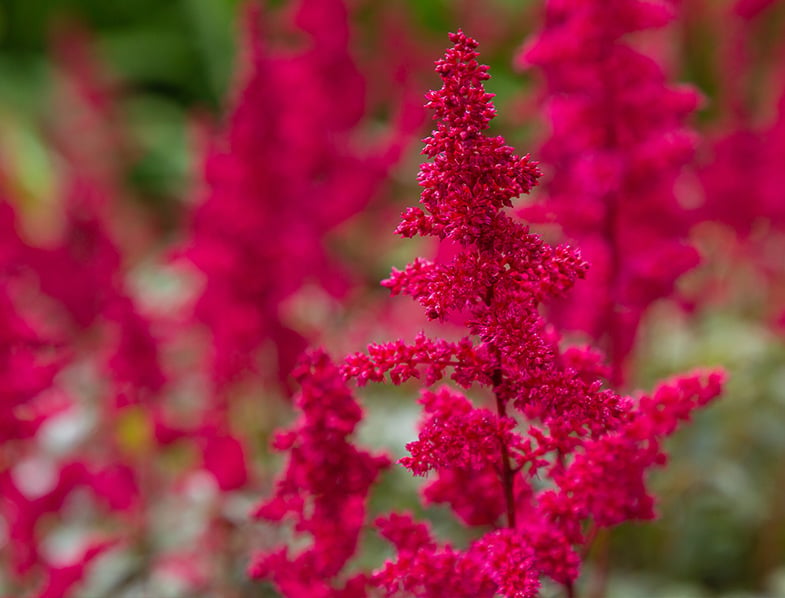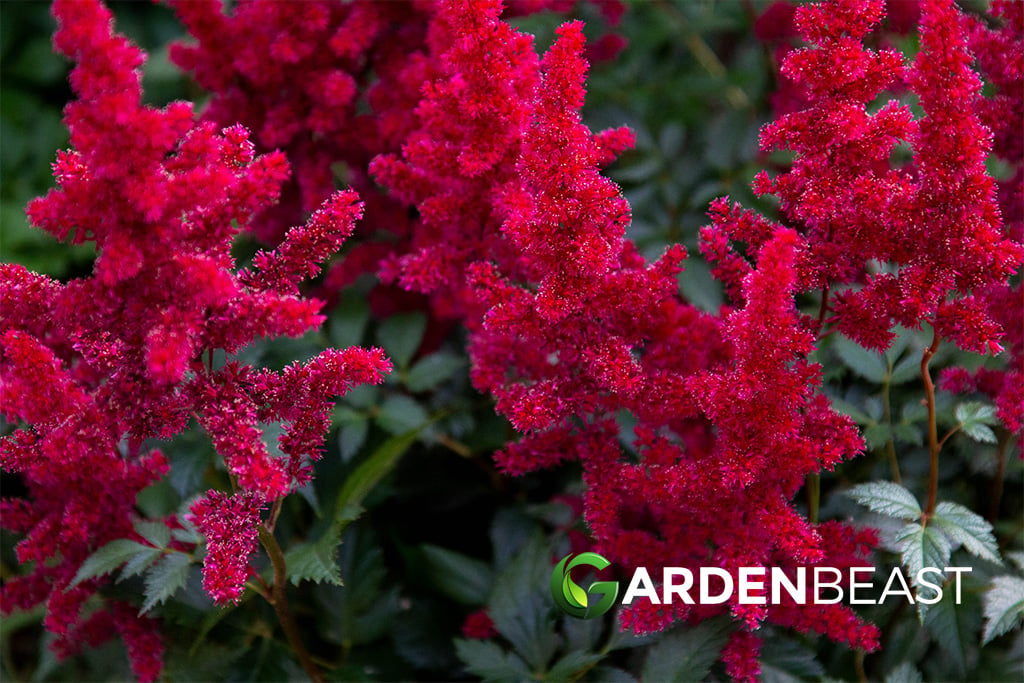Astilbe is a genus that contains about 18 species of vibrant and nice-looking flowering plants in the Saxifragaceae family. The flowers from this genus are native to some regions of Asia and North America. They grow mostly in mountain ravines and woodlands.
Astilbe plants are popular ornamentals that can make eye-catching additions to both outdoor and indoor settings. These flowers look absolutely fabulous in pots, rock gardens, woodlands, perennial borders, beds, and near ponds or streams. They are great edging plants, mass plants, and ground covers. Moreover, some growers use fresh or dry Astilbe cuts in various natural bouquets.
About Astilbe Plants
- In cultivation, they go by several common names, such as the False Goat’s Beard, False Spirea, or simply Astilbe. These plants are big lovers of partial shade, moisture, and can tolerate a wide range of temperatures.
- There are only four commonly accepted cultivar groups of Astilbe plants. These groups are A. Arendsii, A. Crispa, A. Japonica, and A. Simplicifolia.
- Several stunning Astilbe cultivars, including ‘Bridal Veil’, Dwarf Chinese Astilbe, ‘Europa’, ‘Fanal’, ‘Rheinland’, ‘Sprite’, and ‘Superba’, have gained the prestigious Award of Garden Merit.
- Besides the varieties and hybrids mentioned above, there are many other interesting specimens in the gardening world. Some of these are A. ‘Amethyst’, A. ‘Bressingham Beauty’, A. ‘Diamond’, A’Hyacinth’, A. chinensis ‘Maggie Daley’, A. ‘Montgomery’, or A. ‘Red Sentinel’.
- The flowers of False Goat’s Beard plants are irresistible components not only for people but also for other creatures. They are highly attractive to butterflies and other species of insects that visit them pretty often.
- The leaves of some Astilbe species, such as A. thunbergii, are edible. Some people use the cooked young leaves in several culinary recipes. Their leaves are also a nice tea substitute.
- Astible rivularis cultivars played a big part in traditional medicine. People have used them as a treatment against inflammation, bleeding, ulcer, body ache, digestive problems, and other ailments.
- Astilbe plants can make for wonderful ornamental companions to other species of plants like Artemisia ‘Powis Castle’, Coral Bells, Curled Plantain Lily, Lady’s Mantle, Ostrich Fern, and Smooth Hydrangea.
- False Goat’s Beard plants have no toxic effects on humans and animals. You can grow these flowers wherever you want without worrying about the safety of your curious kids or furry friends.

Astilbe Plants Features: An Overview
- Astilbe plants are rhizomatous flowering perennials. Depending on the species, they can reach from 6 inches to 2 feet (15-60 cm) in height and 6 inches to 5 feet (15 cm to 1.52 m) in width.
- Their mound-forming foliage consists of glossy, often fern-like, and finely-textured leaves that grow on upright or arching, green to red stems. In spring, the leaves usually appear in green to blue tints with blushes of bronze-red.
- False Goat’s Beard plants can bloom from early spring through late summer. During this period, they produce feathery, pyramidal-shaped spikes that contain numerous adorable flowers.
- Their blossoms are quite tiny, abundant, and rise gracefully above the showy mound of leaves. They come in various interesting shades of pink, purple, red, cream, or white.
- Even if their blooming period has come to an end, Astilbe plants still provide winter interest. The flowers dry out and turn a beautiful, rich caramel colour that lasts for a very long time.
Growing Astilbe Plants
It is safe to say that Astilbe plants are one of the friendliest perennial ornamentals out there. They are very easy to grow and care for, making them excellent choices for any type of gardener, especially beginners. In general, it will be pretty difficult to disappoint these gorgeous flowers. But, like all plant buddies, they have some particular demands from their owners.
When it comes to lighting, Astilbe plants can tolerate a wide variety of conditions. These flowers usually thrive in partially shaded locations, but they will also grow just fine in full shade or full sunlight. Although they can bloom beautifully in full shade, these plants need some bright and direct light to grow nicely and reach their full size. However, in regions with dry soil or hot temperatures, make sure you protect them from harsh afternoon sunlight because it will burn their foliage.
- Astilbe Arendsii Bunter plant grows as a perennial in USDA Zones: 4 - 8 and is shade tolerant, thriving best in partial shade areas.
- Astilbe grows up to 28 inches in height, making it a wonderful cut flower and dried floral arrangement flower.
- This mix has colors of violet, red, pink, cream, and white that will bloom through summer! They are also deer resistant and perfect for gardens, flower beds, and borders.
- Sow these heirloom seeds at 3 - 5 seeds per plant in moist soil and keep moist until germination occurs in 28 - 35 days.
- Our seeds are always Non-GMO and packaged for the current year.
- Hardiness zone.4-9
- Grow.Sow seeds indoors 6-8 weeks before the average last frost in your area.Use a soft, loose soil mix.Sprinkle seeds on the top of the soil and press them lightly. Astilbe seed needs light to germinate.
- Tall.Grows up to 14-16 in. tall and wide (35-40 cm).
- Use.The perfect perennial for a shady border with dappled light.
- Self-seeding.Grow from seed and enjoy growing with your family.
- USDA Hardiness Zone. Astilbe (false goat's beard, false spirea.) is a low-maintenance, easy-to-care-for perennial with plume-shaped, colorful flowers stand above the ferny foliage, grown in 3-8 (USDA).
- When to plant. You can plant astilbe in either spring or fall but avoid planting in the hottest part of summer.
- Sow. Sow seeds in cell packs or flats, press into soil but do not cover. Astilbe seed needs light to germinate. Kept at 65-70°F., germination of Astilbe seed almost always occurs within 4-5 weeks.
- Sun. Astilbe plants grow best in part shade but can also grow in full sun or full shade. Astilbe will bloom in full shade, but the plants prefer some sunlight to achieve their full size.
- Soil. Astilbe plants prefer fairly rich, moist soil, with a slightly acidic soil pH of around 6.0.
Last update on 2024-10-06 / Affiliate links / Images from Amazon Product Advertising API
Temperature-wise, False Goat’s Beard plants are very tough and can withstand harsh winter conditions. These attractive flowers are typically hardy in USDA zones 3 to 8, so you can grow them outdoors in these climates without any future problems. Once the first hard frost has passed, we recommend you mulch the soil around the stems to bring the soil’s temperature to ideal levels.
Even if Astilbe plants are virtually carefree regarding fungal diseases and pests, some issues may occur in their first year after planting. For example, some intruders like rabbits or groundhogs can bother your young and tender Astilbes. If you manage to protect new growth from these curious damagers, you will not have to worry about anything else in the long run.
Planting Astilbe Plants
The perfect time to plant your newly-bought Astilbe plants is either in spring or autumn. For optimal results, avoid planting these companions during the hottest summer months. If you still must plant them in summer, provide your plants with water regularly until you notice some new growth showing up.
You will have to pay more attention in terms of soil when choosing the right growing medium for your False Goat’s Beard plants. These flowers grow at their best in slightly acidic substrates, with a pH level of around 6.0 or so. Likewise, you should look for soil that is also a bit rich in nutrients and organic matter.
As a general rule, Astilbe plants require lots of phosphorus to bloom profusely. Because of this, you must feed your plants with a phosphorus-rich fertilizer, such as a 10-10-10 or 5-10-5 product. Make sure you apply fertilizer into the soil about two weeks or so before planting or sprinkle some granules right after you have planted them. When these plants become established, you should feed them only once every year in spring.
Pruning your False Goat’s Beard plants is not usually mandatory. These plants grow at a fairly slow pace, so they do not become leggy and unattractive with time. Moreover, their blossoms will eventually dry off, providing a superb overall look for many months. If the flowers start to look ragged, however, you can cut them back in early spring.
Watering Astilbe Plants
Astilbe plants are big lovers of moisture and will not appreciate prolonged periods of drought at all. In general, the warmer the temperatures, the more you will have to provide your plants with water. But when the weather is more on the freezing side, usually in winter, you must water them only when the first half of soil has dried out entirely.
The best way to find out whether is time to give your Astilbe plants a drink or not is to always check their soil in-between waterings. When the top inch (2.5 cm) of soil seems very dry, you can spoil your buddies with a nice, deep soaking. During the hot summer months, keep in mind that you should repeat this process more often than usual.
When False Goat’s Beard plants do not receive the well-deserved moisture, they will not hesitate to show their discontent. If you under-water your flowers, their foliage will turn brown, dry, and eventually die off. The first signs of under-watering typically include bent leaves, but your plants will get back on their feet as soon as you give them a good drink.

Propagating Astilbe Plants
If you are growing your Astilbe plants in an environment that successfully mimics their natural habitat, they will grow more quickly and will generally need frequent division. But this should not worry you at all, because it is a great opportunity to have more of these beauties in your plant family! Plus, it is also a very fun and easy process, requiring no prior experience in the gardening world.
First things first, you must simply dig up the root balls of your Astilbe plants in early spring, when they are in their best shape. After this step, divide their roots into several equal-sized sections using a good old spade. For optimal growth, make sure each divided part has at least one stem attached to it.
Once you have your Astilbe sections, you can transplant them wherever you want at the same soil level as before. After the replanting process, keep the baby plants well-watered to help them settle in their new environment more quickly. As always, do not forget to replant some specimens in pots and surprise your beloved friends and family members with a lovely gift!
In Conclusion
With so many charming cultivars of Astilbe plants, all we can do is step aside and give you time to decide which one would suit you best. We know this is the hardest part! But once you find the perfect companion to add to your beloved collection, make sure you stop by and share your journey with us in the comments!



